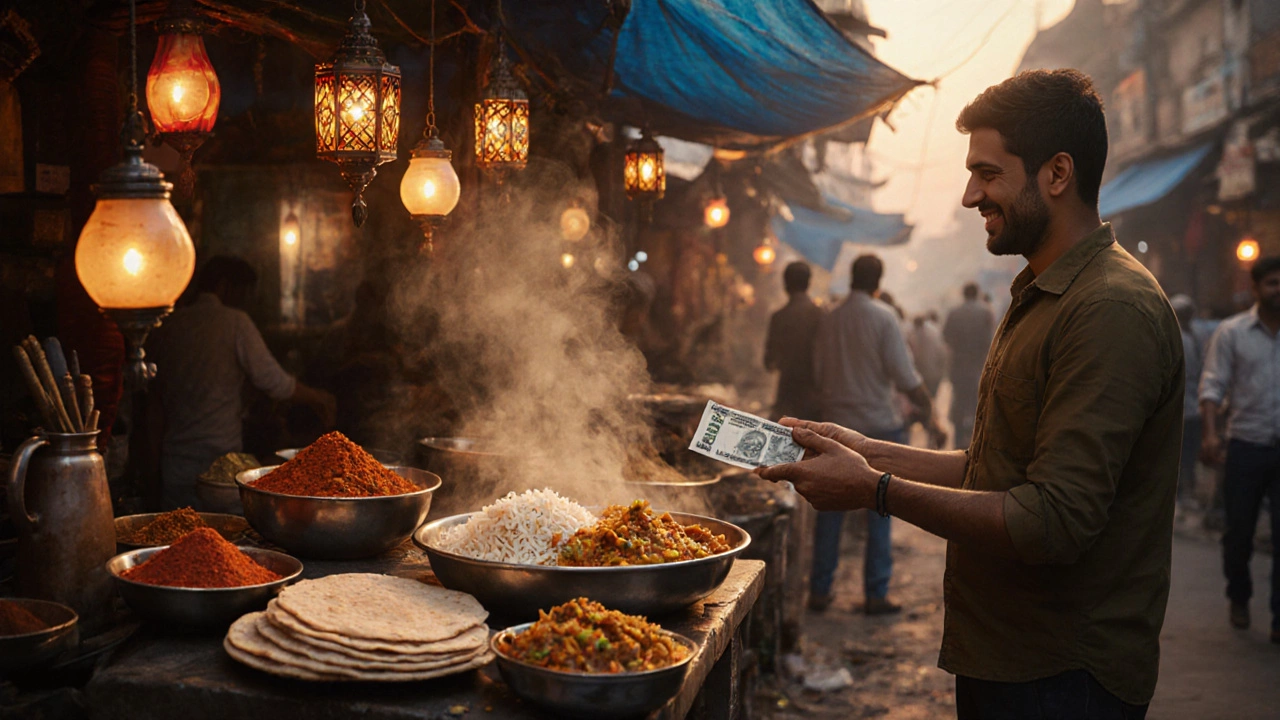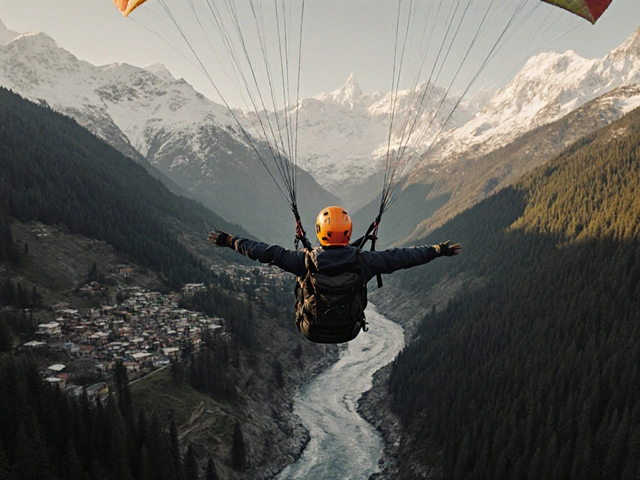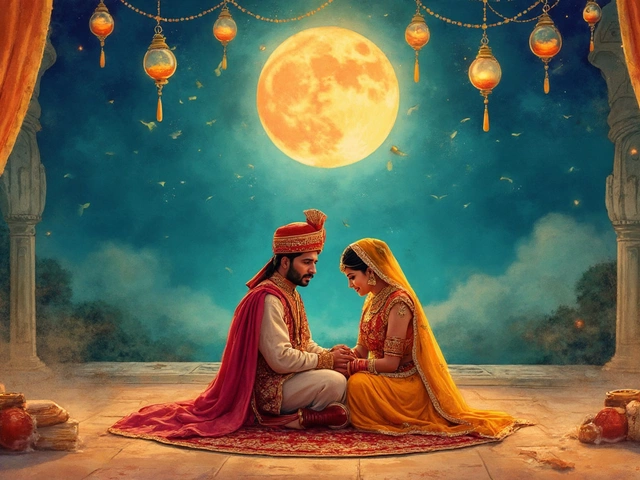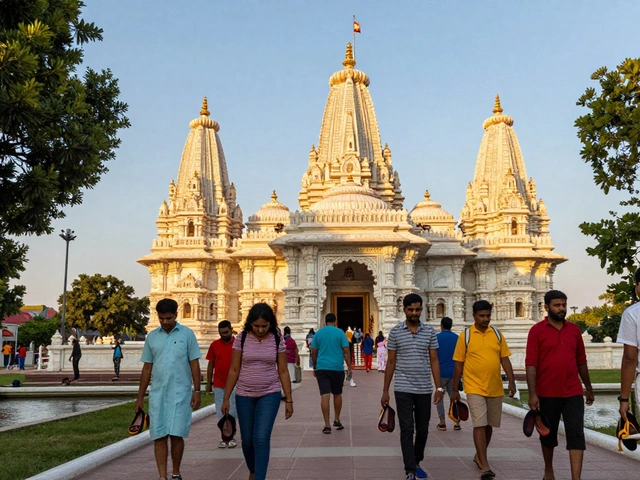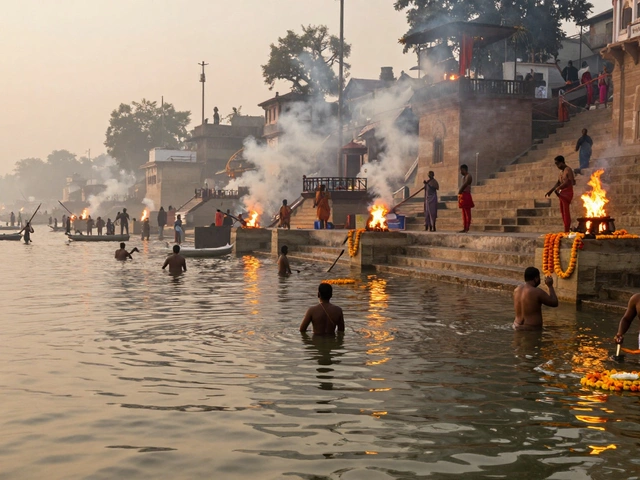One US dollar doesn’t go far in Sydney. A coffee costs $5, a bus ride is $3, and even a bag of chips runs close to $2. But in India? That same dollar stretches further than you’d think. On November 6, 2025, $1 equals about ₹83. That’s not just a number-it’s a bowl of steaming dal rice in Delhi, a 30-minute auto-rickshaw ride in Goa, or three fresh chapatis from a roadside vendor. If you’re planning a budget trip to India, understanding what $1 can actually buy makes all the difference between scraping by and traveling well.
Food: A Full Meal for Less Than a Coffee
Food in India is where your dollar does the most work. Walk into any local eatery-called a dharamshala, chotu dhaba, or just a street stall-and you’ll find meals that cost less than $1. In Mumbai, a plate of pav bhaji with a side of sliced onions and lemon? That’s ₹60, or about $0.72. In Varanasi, a bowl of hot, spiced kachori with chutney? ₹40. In Jaipur, a thali with rice, dal, roti, curry, and yogurt? ₹70. All under a dollar.
Street food isn’t just cheap-it’s authentic. Try a plate of pani puri: six small crispy balls filled with tamarind water, chickpeas, and spices. That’s ₹20. Or a masala chai from a stall with a tin cup: ₹15. You can eat three meals a day in India for under $5. Backpackers who live off street food often spend just ₹150-200 ($1.80-$2.40) per day on food alone.
Transport: Rides That Won’t Break the Bank
Getting around India doesn’t require a rental car or Uber Black. In most cities, a 5-kilometer auto-rickshaw ride costs ₹60-80. That’s under $1. In smaller towns, you can even negotiate a round-trip for the same price. In Delhi, the metro charges ₹10-25 for most trips-so you could ride 10 times for less than $1. In Kerala, a shared jeep from one village to the next? ₹40.
Longer rides? A 200-kilometer bus journey from Bangalore to Mysore costs ₹200-250 ($2.40-$3). That’s less than $1.50 per 100 kilometers. Trains are even cheaper. A non-AC third-class seat on a 4-hour journey? ₹120. That’s $1.45. You’re not just saving money-you’re riding with locals, hearing their stories, and seeing India up close.
Accommodation: A Bed for a Dollar
Yes, you read that right. In many parts of India, you can find a clean, basic bed for $1. Hostels in Goa, Rishikesh, or Udaipur offer dorm beds for ₹80-100. Some guesthouses in rural Rajasthan or Tamil Nadu charge ₹70-90 for a private room with a fan and shared bathroom. These aren’t luxury stays-no AC, no minibar, maybe no hot water-but they’re safe, clean, and often run by families who serve you tea in the morning.
For $5, you can upgrade to a private room with a fan, a decent mattress, and a bathroom with running water. That’s cheaper than a night in a motel in rural Australia. And in places like Hampi or Khajuraho, you’ll find rooms with views of ancient temples for under $10.
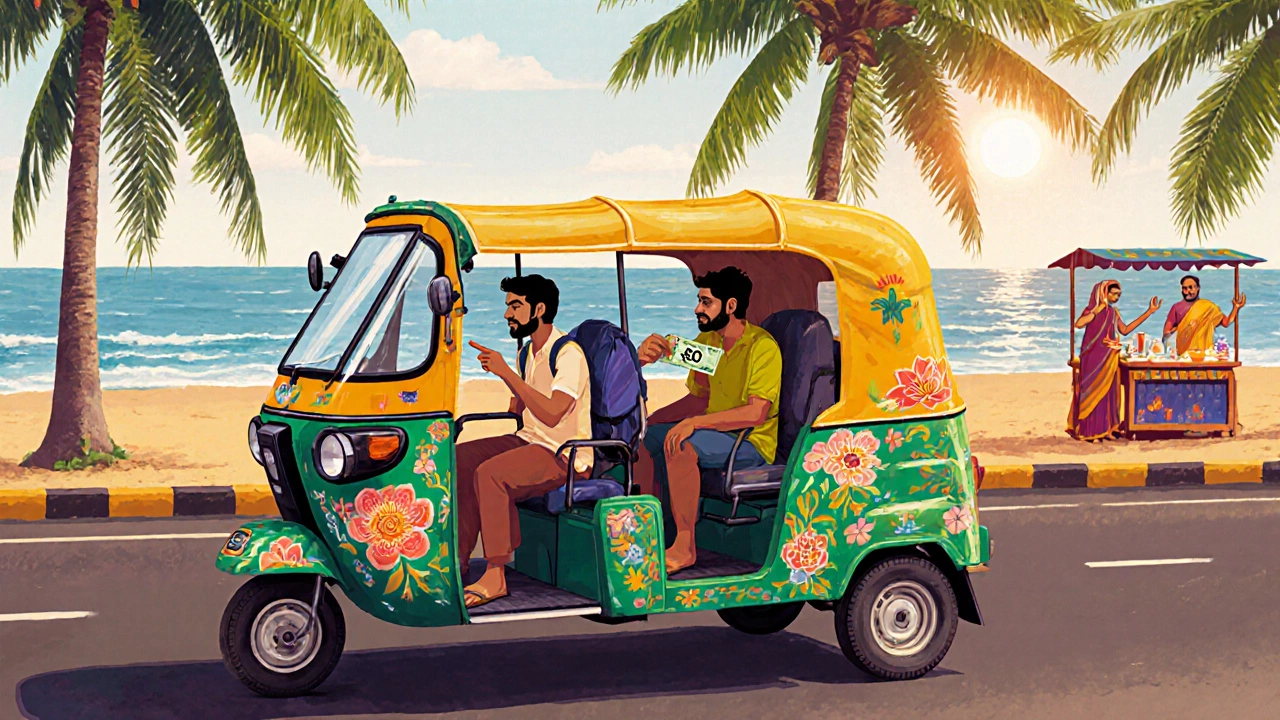
Shopping: Souvenirs That Tell a Story
Forget buying mass-produced trinkets. In India, $1 buys something real. In Jaipur’s Johari Bazaar, you can pick up a small silver ring for ₹80. In Kerala’s spice markets, a small bag of cardamom or turmeric? ₹60. In Varanasi, a handwoven silk bookmark? ₹50. In Delhi’s Dilli Haat, a cotton tote bag made by rural artisans? ₹90.
Even in tourist-heavy areas like Agra or Sarnath, you’ll find handmade items priced fairly. A single wooden elephant carving? ₹100. A set of five colorful prayer flags? ₹70. These aren’t cheap imports-they’re made by local craftspeople using techniques passed down for generations. Buying for $1 means you’re supporting real livelihoods.
Services: Small Things, Big Value
India’s service economy runs on low prices. A 15-minute head massage at a street-side chair? ₹50. A quick haircut? ₹40-60. A phone charging station at a temple or train station? ₹10. A local SIM card with 2GB of data? ₹70. A one-way ferry ride across the Ganges in Varanasi? ₹5.
Even laundry services are affordable. A full bag of clothes washed, dried, and folded? ₹100-150 ($1.20-$1.80). In smaller towns, you can hire someone to clean your room for ₹100 a day. You’re not just paying for a service-you’re connecting with someone who works hard for every rupee.
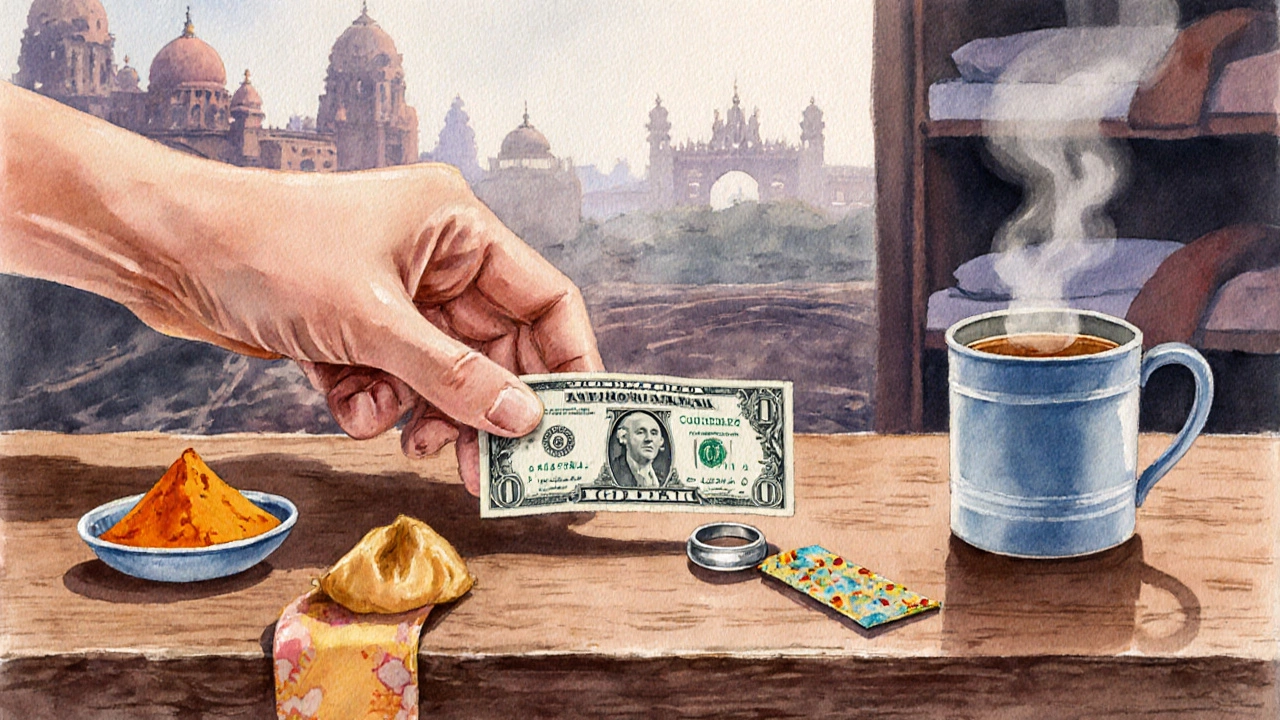
What Can’t Buy (And Why That Matters)
Of course, $1 won’t get you a bottle of imported beer, a Netflix subscription, or a branded T-shirt in a mall. But that’s the point. India’s real value isn’t in what’s branded or imported-it’s in what’s local, fresh, and human-made. The dollar stretches because the economy runs on labor, not markup. A chai wallah doesn’t pay rent in dollars-he pays rent in rupees. His profit margin is small, but his cost of living is low.
That’s why backpackers who live on $10-15 a day can stay in India for months. They’re not just saving money-they’re choosing a different way to travel. One where meals are shared on the floor, rides are had with strangers, and souvenirs come with stories.
Real Numbers: A Day in India on $1
Here’s what $1 looks like in a real day:
- Breakfast: 3 chapatis with potato curry → ₹40 ($0.48)
- Mid-morning chai → ₹15 ($0.18)
- Auto-rickshaw to temple → ₹60 ($0.72)
- Lunch: dal-rice-thali → ₹65 ($0.78)
- Afternoon snack: pani puri (6 pieces) → ₹20 ($0.24)
- Dinner: samosa + tea → ₹35 ($0.42)
Total: ₹235 → $2.82
That’s less than $3 for six meals, two rides, and a snack. And you’re still not counting the free things-sitting under a banyan tree, watching temple rituals, or listening to street musicians. Those cost nothing. But they’re priceless.
Why This Matters for Your Trip
Travelers who come to India expecting to spend like they do at home often leave frustrated. But those who understand the rhythm of Indian prices? They come back. Because when you know $1 buys you a full meal or a ride across town, you stop worrying about budgets. You start noticing details-the smell of cardamom in the air, the way the light hits the Taj Mahal at sunrise, the smile of the woman who handed you your chai without asking for more.
India doesn’t ask you to spend a lot to feel rich. It teaches you that richness isn’t about how much you spend-it’s about how much you experience.
Is $1 enough for a full meal in India?
Yes, absolutely. A simple meal like dal-rice, roti with curry, or a thali with vegetables, bread, and yogurt costs between ₹60 and ₹80 ($0.70-$1) at local eateries. Street food like pani puri, vada pav, or masala dosa also falls well under $1. Even in cities like Delhi or Mumbai, you can eat well for under $2 per meal.
How much does a hotel cost in India per night?
Basic dorm beds in hostels cost ₹80-120 ($1-$1.50). Private rooms with fan and shared bathroom start at ₹500-700 ($6-$8.50). In rural areas or small towns, you can find clean private rooms for ₹700-900 ($8.50-$11). Luxury stays are available, but budget travelers rarely need them.
Can I use US dollars in India?
No. India uses the Indian rupee (₹). While some high-end hotels or tourist shops might accept USD, the exchange rate they offer is terrible-often worse than banks. Always carry rupees. Withdraw cash from ATMs using your international card, or exchange USD at authorized money changers in airports or cities. Keep small bills for street vendors.
Is India safe for budget travelers?
Yes, if you use common sense. India is generally safe for solo travelers, including women. Stick to well-lit areas at night, avoid unmarked auto-rickshaws, and keep valuables hidden. Most locals are helpful and honest. Petty theft happens, but violent crime against tourists is rare. Trust your instincts-most people you meet will go out of their way to help you.
What’s the best way to get rupees in India?
Use ATMs. Most international cards work on Indian ATMs, and you’ll get the best exchange rate. Avoid currency exchange counters at airports-they offer poor rates. If you must exchange cash, go to a bank or authorized money changer in the city. Always check the rate before exchanging. Carry ₹500 and ₹2000 notes for larger purchases, but keep smaller bills for daily spending.
How much should I budget per day in India?
A tight budget: ₹800-1,200 ($10-$15) covers food, basic lodging, and local transport. A comfortable budget: ₹1,500-2,500 ($18-$30) adds in entry fees, better meals, and occasional rides. Luxury? That’s up to you-but most travelers find they don’t need it. You can see India’s highlights on $15 a day and still have money left for souvenirs.
